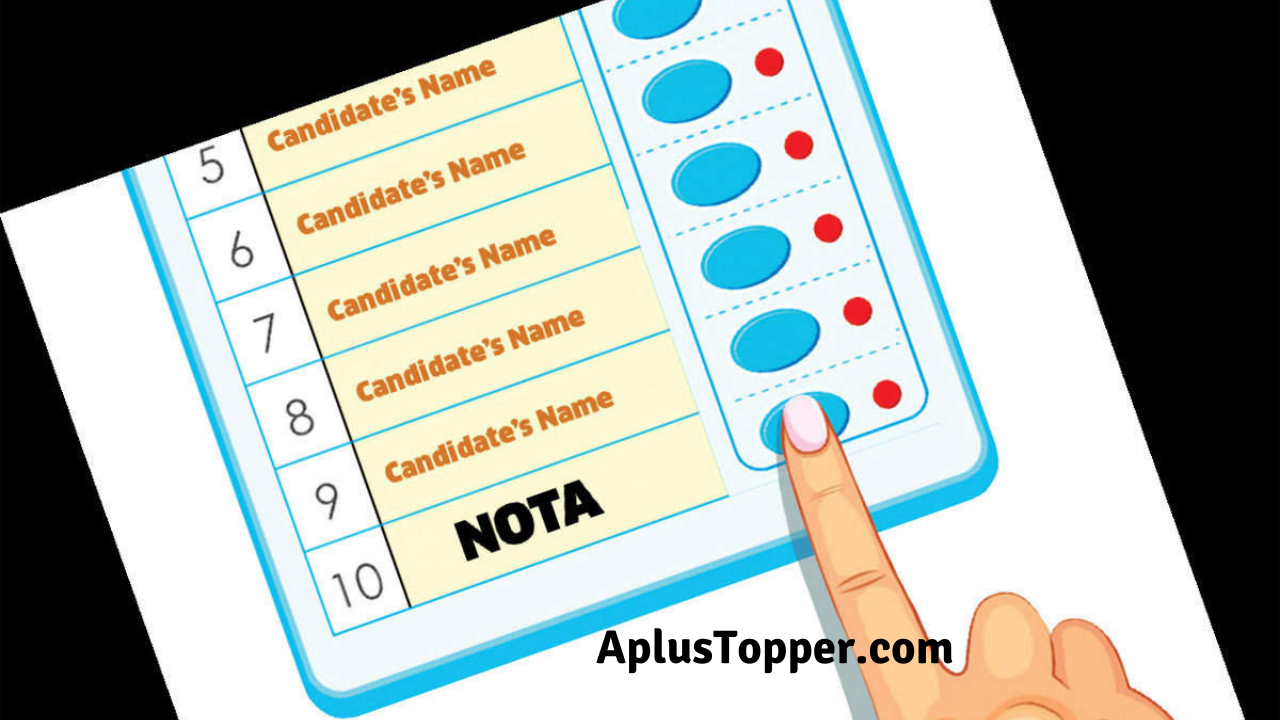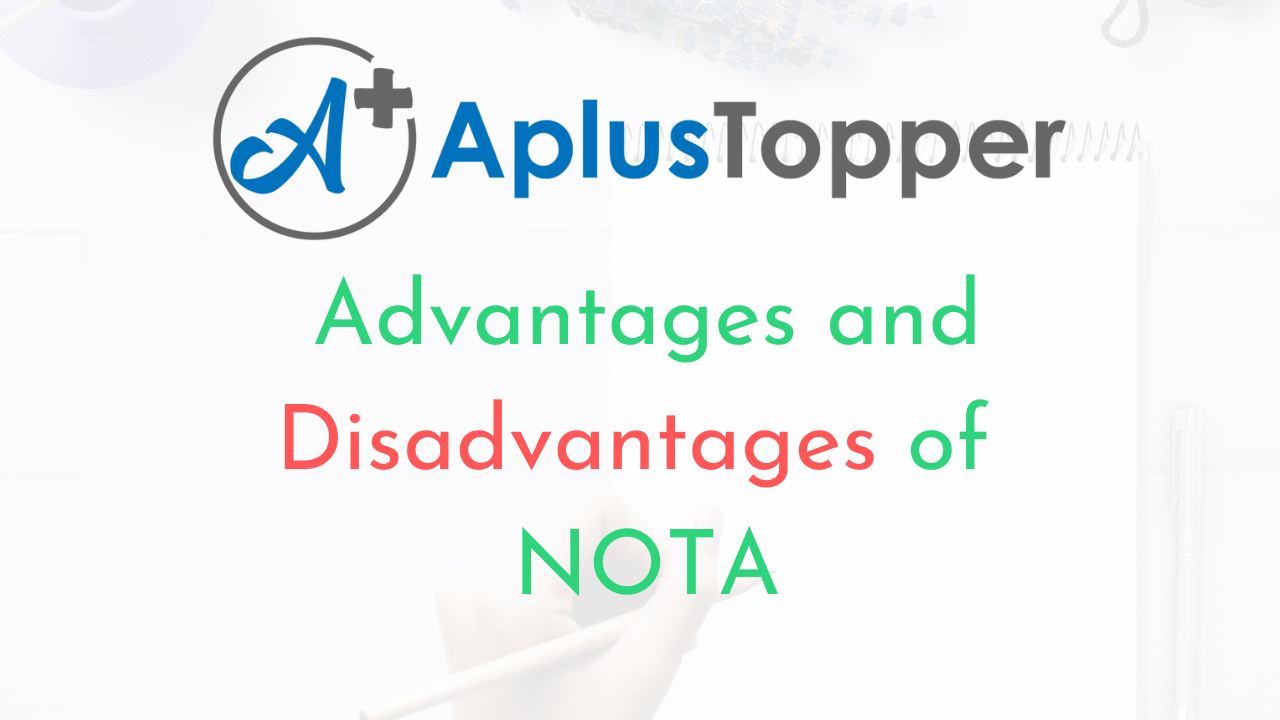NOTA Advantages and Disadvantages: NOTA might seem like an old term to any but, it came into force in recent 2013. During elections in Madhya Pradesh, Rajasthan, Mizoram, Chhattisgarh, and Delhi, the assembly used this system.
In September of 2013, the government introduced NOTA through a Supreme Court directive mentioned in the Union of India versus People’s Union for Civil Liberties case to present the NOTA or ‘None of the above buttons in the election EVMs, whereby supporting a citizen’s right to vote for none of the parties along with the right to secrecy.
Previously, before the introduction of NOTA, citizens could choose to vote for none of the parties, but the process was tiresome. The criterion existed in Section 49 (O) of the Conduct of Election Rules of 1961.
Students can also find more Advantages and Disadvantages articles on events, persons, sports, technology, and many more.
As per the Section, the voter was permitted to cast a negative vote through Form 17A of the act, which would also have to pass through the supervising officer; hence privacy was not as strong.
Considering these issues, the government suspended the existing section and implemented the new NOTA policy to aid vote casters.
- The significant features of NOTA
- The Advantages of NOTA
- The Disadvantages of NOTA
- A Comparison Table for the Advantages and Disadvantages of NOTA
- FAQS on pros and cons of NOTA
NOTA is an abbreviation used for the phrase ‘None of the Above.’ To put it plainly, it gives the balloter the right to express a negative conclusion by not selecting any of the competitors in the fray.
The Supreme Court envisioned NOTA to cleanse the political system by quoting that negative voting will begin a systemic change in the polls, and votes will force political parties to propose clean nominees during the elections.
The Advantages and Disadvantages of NOTA are explained in detail in this article.
Significant Features of NOTA
The NOTA option is very significant for citizens. The primary objective of the NOTA button is to help electors who do not wish to vote for any of the listed candidates in order to exercise their voting right to refuse the parties without breaching the privacy of their personal decision. The voter must be qualified to record a rejection vote if they feel it necessary that the contesting competitors are undeserving of their vote. The freedom to vote awarded to all citizens is a compulsory obligation that must allow the vote of rejection whenever the citizen chooses to exercise it.
Advantages of NOTA
Maintenance of equality and prevents false voting: NOTA helps maintain the freedom to equality of citizens by omitting the discrimination based on caste, creed, gender, and religion and provides fair opportunities to every vote caster not to vote and exercise the option of NOTA when felt necessary.
NOTA also prevents false voting due to its higher aggregates of being the end result, preventing fake votes by people.
Maintenance of privacy and freedom of expression: The best feature of the NOTA policy is the maintenance of privacy of vote casters. Due to political dominance in a particular region, people might be affected or worried about privacy while voting. NOTA allows them to vote free of worry.
The policy allows citizens to have the right to heresy for any particular party. Rejecting all parties is also a suitable choice that people should respect.
Honest votes and increased cooperation among citizens: NOTA allows elections to be successfully held. When there are not desirable candidates on ballots, citizens choose not to vote as a respectable option.
Due to the advent of NOTA, people have started to perceive casting no votes as a good option rather than wasting their polling rights and bringing transparency to the elections system.
According to the citizens, when there are no desirable parties, they chose not to vote as an option. Still, with the emergence of NOTA, the system raised voting participation contrasted to the earlier estimated data.

Disadvantages of NOTA
- Serves as a block for administrative parties: NOTA serves as a block for administrative parties. Suppose the NOTA option acquires more votes than the remaining parties present on the ballot. In that case, another party that holds the second-highest votes can still be the ruling party. Hence, NOTA receiving the highest votes will produce a coalition of non-supporting voters and become a non-cooperative option for the party.
- Abuse of NOTA by the voters: Nota becomes the subject of misuse by those uninterested in voting and overlooks the abilities of the contesting parties on the ballot and just vote to exercise their right and not vote by choice.
- Abuse of NOTA by political powers: Following the approach of NOTA, citizens gave formed different options in voting, which has also raised the extreme domination and authority of the political party on voters not to choose the NOTA option and vote for those parties.
Comparison Table for Advantages and Disadvantages of NOTA
| Advantages | Disadvantages |
| NOTA helps in the maintenance of equality for citizens irrespective of their caste, creed, gender or religion during the process of elections. It also prevents bogus votes by omitting the option for casting false votes from the ballot. | NOTA sometimes blocks political parties in the process of voting since non-casters can rally up against winning parties to pull them down. |
| Privacy in the system of voting can be maintained by exercising the NOTA option during voting. The NOTA option also enables vote casters to express their true opinion if they feel none of the candidates are suitable to their opinion. | Sometimes voters who are uninterested in the elections simply press NOTA to exercise their voting rights and not by choice. This is a way in which vote casters can corrupt the voting process during the elections. |
| By exercising NOTA, vote casters can cast honest votes and citizens have started to consider NOTA a good option in the process of election. The implementation of this system has also increased cooperation among the citizens and they can choose to vote as an option. | The political dominance in a region can also prompt citizens to vote NOTA in any specific region by displaying supremacy over the citizens of that region. |

FAQ’s on Pros and Cons of NOTA
Question 1.
How can an individual Cast a NOTA Vote?
Answer:
The Electronic Voting Machines used during elections have the NOTA button at the bottom of the nominees’ list. Previously, a voter had to notify the supervising officer at the polling booth to cast a negative vote. Now, the NOTA vote does not demand the engagement of the supervising officer.
Question 2.
Is NOTA considered as a standard practice internationally?
Answer:
Countries such as Ukraine, Colombia, Brazil, Finland, Bangladesh, Spain, Chile, Sweden, France, Greece, and Belgium allow citizens to cast the NOTA vote. The state of Texas and other US states sanctions the NOTA provision since 1975.
Question 3.
What was the requirement for NOTA in India?
Answer:
Negative voting will commence a systemic change in ballots and force political parties to propose clean nominees. Suppose a citizen’s right to vote is a legal right.
In that case, the freedom to refuse a candidate is a fundamental right of speech and expression as mentioned under the Constitution, as proposed by Chief Justice of India, Sir P Sathasivam.
The court also named that the system of negative voting subsisted in numerous other countries. In the Parliaments, the MPs have the choice of abstaining from the vote.
Question 4.
What if the NOTA option gets the most votes?
Answer:
Suppose NOTA wins the highest number of votes from the voters during an election. In that case, the government should hold re-election in that constituency with fresh candidates or new voters, or the Governor should rule that area with the highest votes on NOTA.
